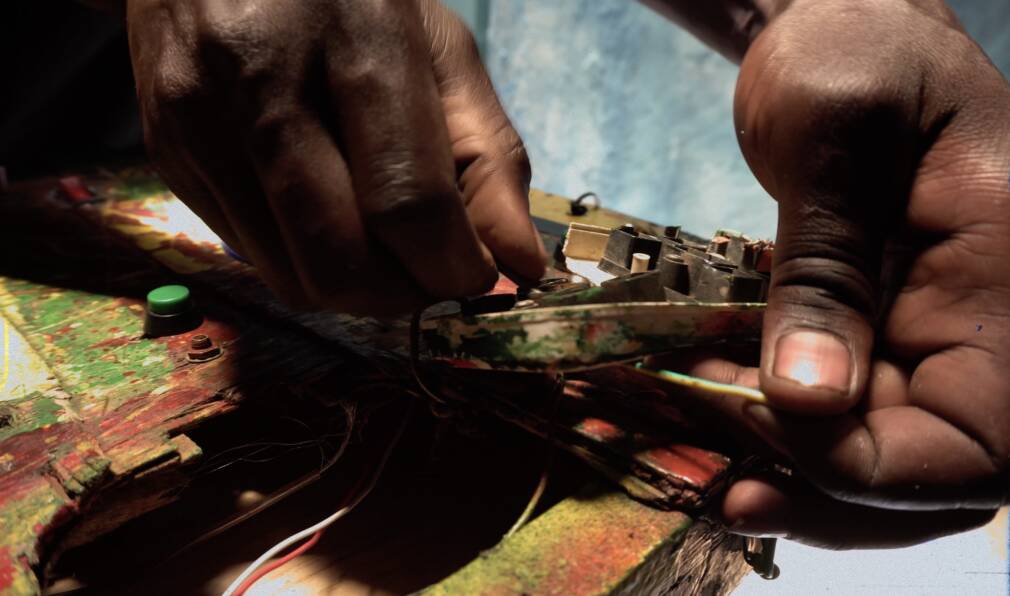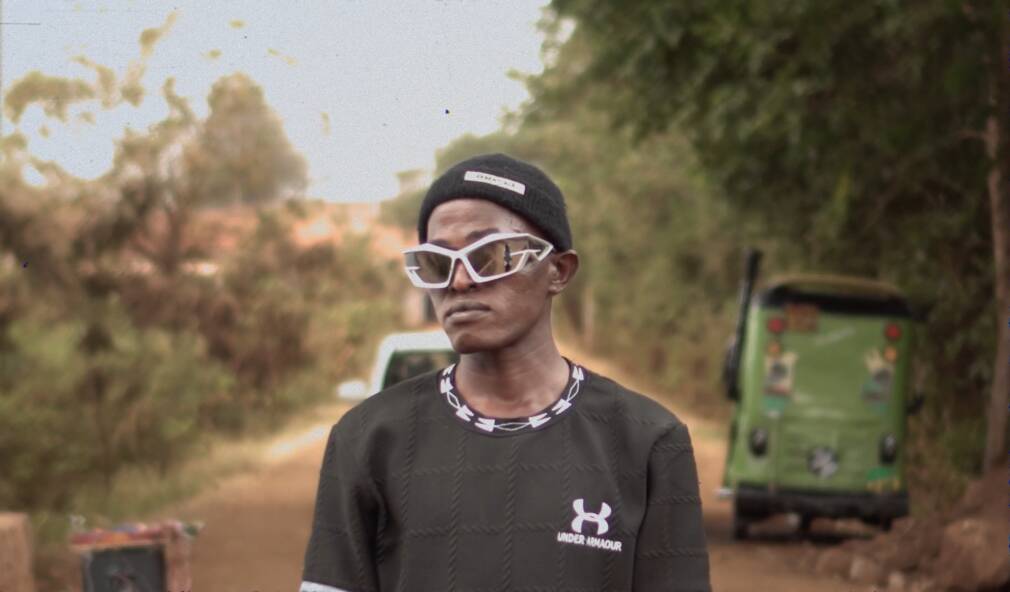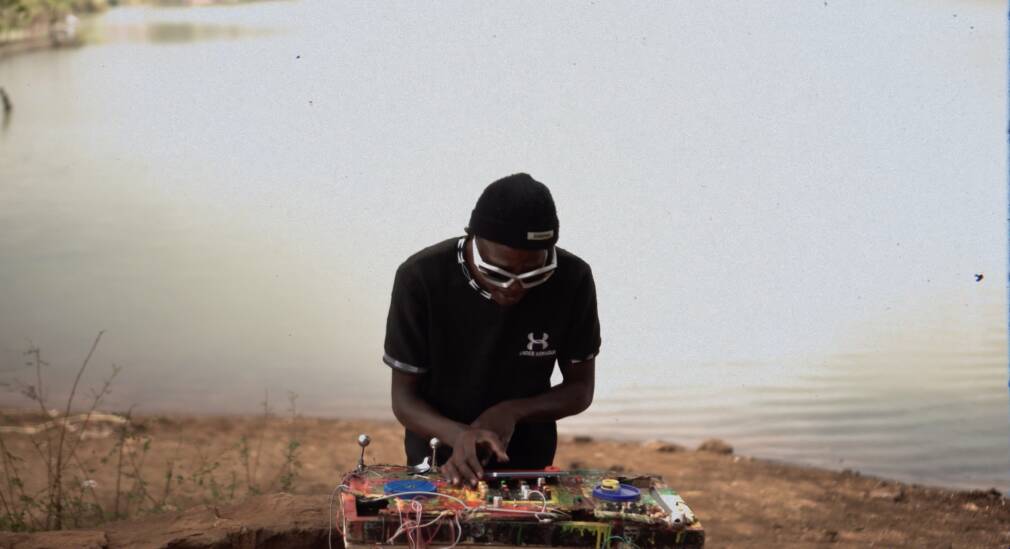“This is the spoon for eating music!” DJ Boboss exclaims as he motions to a mangled tablespoon connected to a slim magnetized wire protruding from a wooden box that functions as his make-shift DJ decks. Also attached to the box are a pair of metallic knobs taken from a towel rack, the nozzle of a kettle, the tiny mixing unit of a battery, several bottle caps, and miscellaneous colorful wires. This particular set of decks is painted red, green, and yellow and covered in scratch marks, dents, and wax drippings, a testament to years of persevering trial and error.
The self-taught DJ, producer, artist, and electrician has been feeding on music since class 3, when his dad bought him a “small one-battery radio,” and he was fascinated by the voices that emanated from the mysterious box. “I wanted to know how small those people who are talking on the radio are.” In his curiosity, he deconstructed the device and accidentally cut a wire, rendering it unusable. His dad was unable to buy him another one, so Boboss had no choice but to learn how to fix the radio himself. Therein began his life-long journey in sound and physics.
Driven by an unwavering fascination, it did not take long for Boboss to become fluent in the language of electrical engineering. “The little I would learn from school, I would come home and apply.” The whole community used to bring me their worn-out radios. I would just do research and play with the different parts until I made something new. Before he finished primary school, he had already gained favour within his community as a handyman, fixing worn-out radios and other household electronics like clocks and torches. One fateful day, he stumbled into a local club with some friends and saw a DJ using a mixer for the first time. “I was so amazed by the skills he was using and how the crowd was moving. The way he was cutting and transitioning the music Just by looking, I knew that I could do something like that using the available resources I have in the house.”
He first fashioned a microphone by retro-fitting a cassette radio and a discarded amplifier, then built his first wooden mixer using a series of magnetized metal pieces to act as cuts for the music. He used the same discarded amplifier as the central unit, where he separated the mids, highs, and lows. By the time he started high school, he had established his own pirate radio station broadcasting to a local 200-metre radius—just enough to reach friends and neighbours in his small village on the outskirts of the central Kenyan town of Meru. All this came from a collection of ramshackle DIY equipment that he willed into existence out of sheer curiosity.
Though he had won the favour of his friends and age-mates, who were enamoured by his boisterous persona and platform, Boboss’s talents were not always met with enthusiasm by the majority of his community, which was gripped by a deep and rigid religious code. Rather than meeting his gift as a divine blessing, it was seen as demonic interference. “They thought I was crazy because I was doing extraordinary things. They said that ‘this guy is not in the world that we are living in. It’s his mind that is showing him these things.’” His own grandmother feared that he was possessed.

At the start of his secondary school studies, he was forcefully admitted into a mental institution and pumped with a cocktail of antidepressants and neuroleptics that sunk him into a year-long depression. “They chased me and tied me with ropes,” he solemnly recalls. As he grew older, there was increasingly less space in his community for him to nurture or showcase his creative passion. His new obsession was to escape. “I knew that there was some place where people would appreciate my talents. I just had to find them.” He continued working as an electrician but had to shut down his radio station and stop hosting the impromptu public performances he enjoyed so much. Eventually, he saved enough money to move to Nairobi, Kenya’s capital, with dreams of connecting with more open-minded people.
Since then, he has flourished as a DJ and icon of Kenyan underground music culture. He is renowned across Nairobi for his impromptu public DJ sets, known to capitulate hundreds. His online following is in the hundreds of thousands and has knocked an Adidas partnership, Boiler Room set, Nyege Nyege performance, and several local press features off his checklist. In his new neighbourhood in Juja Town, 30 kilometres northeast of Nairobi, he is a local celebrity for his impromptu public performances. He spontaneously rotates between spots like the taxi stage, local market, or a nearby dam and plays his unique dancehall blend for as many as 10–100 people at a time. His musical palette is a cocktail of dance music from across Africa’s diaspora, with an emphasis on dancehall, reggae, and homegrown East African sounds. Heavy bass, bright synths and horns, and infectious melodies
Inspired by the likes of Konshens and Vybz Kartel, Boboss has an enigmatic dancehall swagger about him. On and off camera, he maintains the exuberance of a toastmaster, speaking in an English-sheng-patois mix, often interjecting ad-libs and poses into his normal speak. “Ya dun know!” he exclaims after explaining the science of the magnetised cut function on his decks.
“In the meantime, DJ Boboss is the boss!”
As he shows us around his home or studio, there is an electric drive in everything he does—a sense of boundless possibility. It is a concrete room with a skylight, filled with speakers, 5 or 6 wooden decks, and a large box of wires, nails, bottle caps, knobs, and other miscellaneous small items he uses to construct and maintain his equipment. In the adjacent living room, there is a drum set and guitar perched next to a portable recording setup. He doesn’t know how to play either. “I just saw it and thought, ‘I would like to know how to play a drum set,’ so I bought it. Now my job is to learn!” A series of prototype wooden mixers line the wall. They are part of an art exhibit he is contributing to a gallery in Detroit.
He is extremely comfortable and actively engaged with all of the objects in his space. There is a point, as he is demonstrating how to use his signature decks, where the music becomes choppy and interrupted. Boboss instinctually reached for a lighter and burned the plastic off of one of the many protruding wires. He twisted the revealed metallic strips together and promptly resolved the issue. Moments later, he quickly reaches for a soda cap, pierces it with a nail, and attaches it to a metallic knob on the deck, which turns out to be a dysfunct fader. Now, as he twists it back and forth, he can manipulate the bass frequencies. He makes all these repairs in real time as the music plays on. All the while dancing and toasting over the song. “Kwanini kesho!”
It is a whimsical guerilla approach to sound manipulation reminiscent of Lee Scratch Perry, constantly and spontaneously experimenting and re-inventing. His equipment is an extension of himself, and he plays it like an instrument. He’s never even bothered to learn how to use conventional decks. In this video essay, PAM takes viewers into the world of DJ Boboss as he breaks down his one-of-a kind mixers and recounts his musical creative journey.





